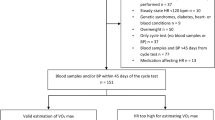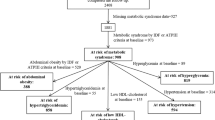Abstract
OBJECTIVE: To investigate the contribution of serum lipids, parameters of glucose metabolism, body composition and cardiovascular fitness to the variance of several haemostatic risk factors for coronary heart disease (CHD) in obese children and adolescents.
SUBJECTS AND MEASUREMENTS: Forty-two healthy, obese children and adolescents (20 male, 22 female, age 12.6±3.2 y; body mass index (BMI), 30.4±5.3 kg/m2), were screened for haemostatic and metabolic risk factors for CHD. Thirty-five of the participants (18 male, age 13.5±2.9 y; BMI, 29.9±4.5 kg/m2; 17 female, age 12.8±2.1 y, BMI, 31.1±5.3 kg/m2) were assessed for cardiovascular fitness by means of incremental cycle ergometer exercise.
RESULTS: After adjustment for age, fat mass correlated significantly with plasminogen activator inhibitor-1 antigen (PAI-1-Ag) in boys and girls and factor VIIc only in girls. Children with lower power output (≤ 2.77 W/kg) showed significantly higher values for factor VIIc, fibrinogen and tissue-type plasminogen activator antigen (tPA-Ag). Neither body composition nor cardiovascular fitness contributed independently to the variance of the determined haemostatic risk factors, except PAI-1-Ag, which has been shown to be determined by fat mass. In multiple linear regression analysis, triglycerides and PAI-1-Ag explained significant independent proportions of the variance of tPA-Ag. Factor VIIc was explained by C-peptide, insulin and fibrinogen. Von Willebrand factor antigen (vWF-Ag) was significantly related to glucose and insulin.
CONCLUSION: The results suggest that in obese children and adolescents the haemostatic risk factors factor VIIc, vWF-Ag and tPA-Ag are mainly determinated by plasma insulin and triglyceride concentrations, but are primarily independent of body composition and cardiovascular fitness.
This is a preview of subscription content, access via your institution
Access options
Subscribe to this journal
Receive 12 print issues and online access
$259.00 per year
only $21.58 per issue
Buy this article
- Purchase on Springer Link
- Instant access to full article PDF
Prices may be subject to local taxes which are calculated during checkout
Similar content being viewed by others
References
Barrett-Connor EL . Obesity, atherosclerosis, and coronary artery disease Ann Intern Med 1985 103: 1010–1019.
De Fronzo RA, Ferrannini E . Insulin resistance: a multifaceted syndrome responsible for NIDDM, obesity, hypertension, dyslipidaemia, and atherosclerotic cardiovascular disease Diabetes Care 1991 14: 173–194.
Juhan Vague I, Alessi MC . PAI-1, obesity, insulin resistance and risk of cardiovascular events Thromb Haemost 1997 78: 656–660.
Landin K, Stigenadal L, Eriksson E, Krotkiewski M, Risberg B, Tengborn L, Smith U . Abdominal obesity is associated with an impaired fibrinolytic activity and elevated plasminogen activator inhibitor-1 Metabolism 1990 39: 1044–1048.
Caprio S, Bronson M, Sherwin RS, Rife F, Tamborlane WV . Co-existence of severe insulin resistance and hyperinsulinaemia in pre-adolescent obese children Diabetologia 1996 39: 1489–1497.
Must A, Strauss RS . Risks and consequences of childhood and adolescent obesity Int J Obes Relat Metab Disord 1999 23 (Suppl 2): S2–11.
Berenson GS, Srinivasan SR, Bao W, Newman WP 3rd, Tracy RE, Wattigney WA . Association between multiple cardiovascular risk factors and atherosclerosis in children and young adults. The Bogalusa Heart Study New Engl J Med 1998 338: 1650–1656.
De Pergola G, De Mitrio V, Giorgino F, Sciaraffia M, Minenna A, Di Bari L, Pannacciulli N, Giorgino R . Increase in both pro-thrombotic and anti-thrombotic factors in obese premenopausal women: relationship with body fat distribution Int J Obes Relat Metab Disord 1997 21: 527–535.
Salomaa V, Stinson V, Kark JD, Folsom AR, Davis CE, Wu KK . Association of fibrinolytic parameters with early atherosclerosis. The ARIC Study. Atherosclerosis Risk in Communities Study Circulation 1995 91: 284–290.
Van der Bom JG, de Knijff P, Haverkate F, Bots ML, Meijer P, de Jong PT, Hofman A, Kluft C, Grobbee DE . Tissue plasminogen activator and risk of myocardial infarction. The Rotterdam Study Circulation 1997 95: 2623–2627.
Ridker PM, Hennekens CH, Cerskus A, Stampfer MJ . Plasma concentration of cross-linked fibrin degradation product (D-dimer) and the risk of future myocardial infarction among apparently healthy men Circulation 1994 90: 2236–2240.
Meade TW, Ruddock V, Stirling Y, Chakrabarti R, Miller GJ . Fibrinolytic activity, clotting factors, and long-term incidence of ischaemic heart disease in the Northwick Park Heart Study Lancet 1993 342: 1076–1079.
Folsom AR, Wu KK, Rosamond WD, Sharrett AR, Chambless LE . Prospective study of haemostatic factors and incidence of coronary heart disease: the Atherosclerosis Risk in Communities (ARIC) Study Circulation 1997 96: 1102–1108.
Cigolini M, Targher G, Agostino G, Tonoli M, Muggeo M, De Sandre G . Liver Steatosis and its relation to plasma haemostatic factors in apparently healthy men—role of the metabolic syndrome Thromb Haemost 1996 76: 69–73.
DeSouza CA, Jones PP, Seals DR . Physical activity status and adverse age-related differences in coagulation and fibrinolytic factors in women Arterioscler Thromb Vasc Biol 1998 18: 362–368.
Koenig W, Sund M, Doring A, Ernst E . Leisure-time physical activity but not work-related physical activity is associated with decreased plasma viscosity: results from a large population sample Circulation 1997 95: 335–341.
Stratton JR, Chandler WL, Schwartz RS, Cerqueira MD, Levy WC, Kahn SE, Larson VG, Cain KC, Beard JC, Abrass IB . Effects of physical conditioning on fibrinolytic variables and fibrinogen in young and old healthy adults Circulation 1991 83: 1692–1697.
Must A, Dallal GE, Dietz WH . Reference data for obesity: 85th and 95th percentiles of body mass index (wt/ht2) and triceps skinfold thickness. [Published erratum appears in Am J Clin Nutr 1991 54: 773.] Am J Clin Nutr 1991 53: 839–846.
Clauss A . Gerinnungsphysiologische Schnellmethode zurBestimmung des Fibrinogens Acta Haemat 1957 17: 237–246.
Schwingshandl J, Borkenstein M . Changes in lean body mass in obese children during a weight reduction program: effect on short term and long term outcome Int J Obes Relat Metab Disord 1995 19: 752–755.
Schaefer F, Georgi M, Zieger A, Scharer K . Usefulness of bioelectric impedance and skinfold measurements in predicting fat-free mass derived from total body potassium in children Pediatr Res 1994 35: 617–624.
Hofmann P, Pokan R, von Duvillard SP, Seibert FJ, Zweiker R, Schmid P . Heart rate performance curve during incremental cycle ergometer exercise in healthy young male subjects Med Sci Sports Exerc 1997 29: 762–768.
Sudi K, Gallistl S, Muntean W, Borkenstein M . The relationship between plasminogen activator inhibitor-antigen, fat mass, and leptin in obese children and adolescents Metabolism 2000 (in press).
Eriksson P, Nilssson L, Karpe F, Hamsten A . Very-low-density lipoprotein response element in the promoter region of the human plasminogen activator inhibitor-1 gene implicated in the impaired fibrinolysis of hypertriglyceridemia Arterioscler Thromb Vasc Biol 1998 18: 20–26.
Van Harmelen V, Wahrenberg H, Eriksson P, Arner P . Role of gender and genetic variance in plasminogen activator inhibitor-1 secretion from human adipose tissue Thromb Haemost 2000 83: 304–308.
Eriksson P, Van Harmelen V, Hoffstedt J, Lundquist P, Vidal H, Stemme V, Hamsten A, Arner P, Reynisdottir . Regional variation in plasminogen activator inhibitor-1 expression in adipose tissue from obese individuals Thromb Haemost 2000 83: 545–548.
Janand-Delenne B, Chagnaud C, Raccah D, Alessi MC, Juhan-Vague I, Vague P . Visceral fat as a main determinant of plasminogen activator inhibitor-1 level in women Int J Obes Relat Metab Disord 1998 22: 312–317.
Moreno LA, Fleta J, Mur L, Feja C, Sarría A, Bueno M . Indices of body fat distribution in Spanish children aged 4.0 to 14.9 y J Pediatr Gastroenterol Nutr 1997 25: 175–181.
Heywood DM, Mansfield MW, Grant PJ . Factor VII gene polymorphisms, factor VII:c levels and features of insulin resistance in non-insulin-dependent diabetes mellitus Thromb Haemost 1996 75: 401–406.
Borkenstein MH, Muntean WE . Elevated factor VIII activity and factor VIII-related antigen in diabetic children without vascular disease Diabetes 1982 31: 1006–1009.
Muntean WE, Borkenstein MH, Haas J . Elevation of Factor VIII coagulant activity over Factor VIII coagulant antigen in diabetic children without vascular disease. A sign of activation of the Factor VIII coagulant moiety during poor diabetes control Diabetes 1985 34: 140–144.
Stehouwer CD, Fischer HR, van Kuijk AW, Polak BC, Donker AJ . Endothelial dysfunction precedes development of microalbuminuria in IDDM Diabetes 1995 44: 561–564.
Juhan Vague I, Alessi MC, Vague P . Thrombogenic and fibrinolytic factors and cardiovascular risk in non-insulin-dependent diabetes mellitus Ann Med 1996 28: 371–380.
Tanaka H, Clevenger CM, Jones PP, Seals DR, DeSouza CA . Influence of body fatness on the coronary risk profile of physically active postmenopausal women Metabolism 1998 47: 1112–1120.
Ferguson MA, Gutin B, Owens S, Barbeau P, Tracy RP, Litaker M . Effects of physical training and its cessation on the haemostatic system of obese children Am J Clin Nutr 1999 69: 1130–1134.
Ferguson MA, Gutin B, Owens S, Litaker M, Tracy RP, Allison J . Fat distribution and haemostatic measures in obese children Am J Clin Nutr 1998 67: 1136–1140.
Bjorkman O . Fuel metabolism during exercise in normal and diabetic man Diabetes Metab Rev 1986 1: 319–357.
Koivisto VA, Yki-Jarvinen H, DeFronzo RA . Physical training and insulin sensitivity Diabetes Metab Rev 1986 1: 445–481.
Goran MI, Reynolds KD, Lindquist CH . Role of physical activity in the prevention of obesity in children Int J Obes Relat Metab Disord 1999 23 (Suppl 3): S18–S33.
Acknowledgements
The study was supported by a grant from the Gesellschaft zur Foerderung der Gesundheit des Kindes (EVITA).
Author information
Authors and Affiliations
Corresponding author
Rights and permissions
About this article
Cite this article
Gallistl, S., Sudi, K., Borkenstein, M. et al. Determinants of haemostatic risk factors for coronary heart disease in obese children and adolescents. Int J Obes 24, 1459–1464 (2000). https://doi.org/10.1038/sj.ijo.0801427
Received:
Revised:
Accepted:
Published:
Issue Date:
DOI: https://doi.org/10.1038/sj.ijo.0801427
Keywords
This article is cited by
-
Insulin resistance is associated with at least threefold increased risk for prothrombotic state in severely obese youngsters
European Journal of Pediatrics (2011)
-
Changes in serum interleukin-6 concentrations in obese children and adolescents during a weight reduction program
International Journal of Obesity (2001)
-
Effects of short-term energy restriction and physical training on haemostatic risk factors for coronary heart disease in obese children and adolescents
International Journal of Obesity (2001)



